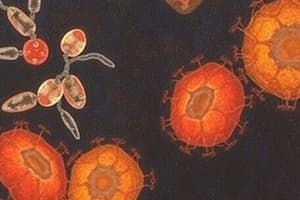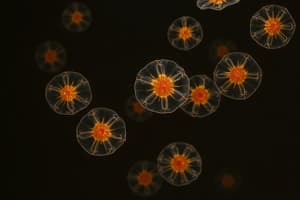Podcast
Questions and Answers
Which of the following best describes the process of generating antibody diversity through "combinatorial diversity"?
Which of the following best describes the process of generating antibody diversity through "combinatorial diversity"?
What is the primary function of B cells in the immune response?
What is the primary function of B cells in the immune response?
Which statement accurately describes T cell receptors (TCRs)?
Which statement accurately describes T cell receptors (TCRs)?
Which process follows the binding of an antigen to a naive B cell?
Which process follows the binding of an antigen to a naive B cell?
Signup and view all the answers
How do memory B cells contribute to long-term immunity?
How do memory B cells contribute to long-term immunity?
Signup and view all the answers
What is the role of antibodies produced by plasma cells in the immune response?
What is the role of antibodies produced by plasma cells in the immune response?
Signup and view all the answers
What is the main role of B cells in the immune system?
What is the main role of B cells in the immune system?
Signup and view all the answers
Which structural feature is unique to T-cell receptors compared to B-cell receptors?
Which structural feature is unique to T-cell receptors compared to B-cell receptors?
Signup and view all the answers
What triggers the rapid clonal expansion of B cells?
What triggers the rapid clonal expansion of B cells?
Signup and view all the answers
What is the role of plasma cells in relation to antibodies?
What is the role of plasma cells in relation to antibodies?
Signup and view all the answers
How do memory B cells contribute to an immune response upon re-exposure to an antigen?
How do memory B cells contribute to an immune response upon re-exposure to an antigen?
Signup and view all the answers
What role do dendritic cells play in adaptive immunity?
What role do dendritic cells play in adaptive immunity?
Signup and view all the answers
Which of the following statements about antibody structure is true?
Which of the following statements about antibody structure is true?
Signup and view all the answers
During the activation of naive B cells, what occurs after they bind to an antigen?
During the activation of naive B cells, what occurs after they bind to an antigen?
Signup and view all the answers
What is the significance of somatic hypermutations in B cells?
What is the significance of somatic hypermutations in B cells?
Signup and view all the answers
Which of the following best describes the immunological memory established by the adaptive immune system?
Which of the following best describes the immunological memory established by the adaptive immune system?
Signup and view all the answers
Flashcards
B-cells
B-cells
Lymphocytes that produce and secrete antibodies, enabling humoral immunity.
T-cells
T-cells
Lymphocytes that detect and kill infected cells, responsible for cell-mediated immunity.
B-cell Receptors (BCR)
B-cell Receptors (BCR)
Membrane-bound antibodies on B-cells that recognize various antigens.
Clonal selection
Clonal selection
Signup and view all the flashcards
Memory B-cells
Memory B-cells
Signup and view all the flashcards
Antibody diversity
Antibody diversity
Signup and view all the flashcards
Variable region
Variable region
Signup and view all the flashcards
Constant region
Constant region
Signup and view all the flashcards
Junctional diversity
Junctional diversity
Signup and view all the flashcards
Somatic hypermutation
Somatic hypermutation
Signup and view all the flashcards
Dendritic cells
Dendritic cells
Signup and view all the flashcards
T-cell maturation
T-cell maturation
Signup and view all the flashcards
Antigen binding sites
Antigen binding sites
Signup and view all the flashcards
Plasma cells
Plasma cells
Signup and view all the flashcards
B-cell activation process
B-cell activation process
Signup and view all the flashcards
Vaccine mechanism
Vaccine mechanism
Signup and view all the flashcards
B-cell production
B-cell production
Signup and view all the flashcards
IgD class
IgD class
Signup and view all the flashcards
Antibody gene segments
Antibody gene segments
Signup and view all the flashcards
Combinatorial diversity
Combinatorial diversity
Signup and view all the flashcards
Antigen presentation process
Antigen presentation process
Signup and view all the flashcards
Study Notes
Antibody Production and Adaptive Immunity
- Antibodies are produced by B cells, which originate in the bone marrow.
- Each B cell clone produces a unique antibody.
- The IgD class of antibodies acts as B cell receptors.
- Antibodies have a variable region (which differs between antibodies) and a constant region (which remains the same).
- The adaptive immune system is not inherited; it is generated de novo.
- B cells differentiate and produce unique antibodies by rearranging antibody gene segments.
- Antibody genes are found in segments on chromosomes.
- There are variable (V), diversity (D), and joining (J) gene segments. The heavy chain has D segments; the light chain does not.
- The number of V gene segments is approximately 30-45.
- Different combinations of V, D, and J segments create immense diversity.
- Combinatorial diversity arises from different combinations of V, D/J gene segments in heavy and light chains.
- Junctional diversity arises from random mutations at the junctions of these gene segments.
- Somatic hypermutation is the continued mutation in the antibody variable region after antigen binding. This enhances antibody affinity (strength of binding).
- Each B-cell clone will have its own unique variable region for light and heavy chains.
- Variable and constant gene segments exist on antibody genes.
- Several joining (J) gene segments exist.
- The heavy chain has several Diversity (D) gene segments.
B Cell Activation and Antibody Secretion
- When a B cell binds to an antigen, it undergoes massive proliferation (clonal selection).
- Activated B cells differentiate into plasma cells or memory B cells.
- Plasma cells secrete large amounts of antibodies, crucial for humoral immunity.
- Antibody production peaks around 5-6 days after infection.
- Some plasma cells remain in the bone marrow, producing low-level antibodies for later use.
- Memory B cells have the same membrane-bound antibody as their activated parent B cell.
- They provide long-lasting immunity, responding rapidly if the same antigen is encountered again. This leads to a rapid response to second infections (usually no symptoms).
- Vaccines work by tricking the immune system into producing antibodies against a weakened form of the pathogen.
- In lymph nodes, B-cell clones make new mutations in their variable regions, increasing antibody affinity.
Adaptive Immune Response
- The adaptive immune system allows the immune system to "remember" previous encounters.
- Vaccines work because of this memory. Memory is controlled by B and T cells.
- The adaptive immune response has two types:
- Humoral response: involves antibodies produced by B cells.
- Cell-mediated response: involves cells directly killing infected cells, aided by T cells.
- Antigen Presenting Cells (APCs): Crucial for initiating adaptive immune responses.
- Macrophages, neutrophils, and the complement system help in attacking pathogens.
- Dendritic cells (DCs) are APCs in external-facing tissues. DCs have long cytoplasmic projections called dendrites.
- DCs utilize pathogen recognition receptors (PRRs) to recognize microbes.
- When exposed to microbes and cytokines, DCs become activated and migrate to lymph nodes to present antigens.
- Lymph fluid circulates throughout the body, driven by muscle movement.
Lymphatic System and Lymph Nodes
- Antigens are presented to B and T cells in lymph nodes.
- Dendritic cells (DCs) and macrophages present antigens; soluble antigens in the bloodstream go to the spleen.
- The pathway for activating the adaptive immune response typically starts with external barriers being breached, microbes enter, DCs engulfing microbes and displaying antigens in the lymph nodes, and naive B cells binding to the antigen then becoming activated.
B cells and T cells (Lymphocytes)
- B cells: Produce and secrete antibodies; essential for humoral immunity. Mature in bone marrow.
- T cells: Detect and kill infected cells; critical for cell-mediated immunity. Mature in the thymus.
- Both B and T cells originate from stem cells in the bone marrow.
- Both migrate to lymph nodes, waiting to be activated.
B Cell Receptors (BCRs)
- BCRs are membrane-bound antibodies (IgD).
- BCRs consist of two heavy chains and two light chains, linked by disulfide bridges to form an antigen-binding site (x2).
- The variable region of the antibody chain determines the antigen-binding site.
- BCRs recognize a wide variety of antigens (carbohydrates, lipids, DNA, proteins, etc.).
T Cell Receptors (TCRs)
- TCRs have one antigen-binding site.
- TCRs recognize peptide antigens presented by other cells.
- TCRs are made using similar gene arrangements as antibodies.
- TCRs consist of an alpha chain and a beta chain joined by disulfide bonds.
Clonal Selection
- In lymph nodes, antigens are recognized by naive B cells via their BCRs.
- The B cell that recognizes the specific antigen proliferates (clonal selection), creating many B cell clones that then differentiate.
- Differentiation leads to plasma cells or memory B cells.
Studying That Suits You
Use AI to generate personalized quizzes and flashcards to suit your learning preferences.
Description
Test your knowledge on antibody production and the workings of the adaptive immune system. This quiz covers B cell differentiation, antibody classes, and the genetic mechanisms that generate antibody diversity. Dive deep into the concepts of combinatorial and junctional diversity within the immune response.
![Lecture 05: Antibody Production and Adaptive Immunity [MCQ 1]](https://images.unsplash.com/photo-1591185157258-11aec5f039d0?crop=entropy&cs=srgb&fm=jpg&ixid=M3w0MjA4MDF8MHwxfHNlYXJjaHw0fHxhbnRpYm9keSUyMHByb2R1Y3Rpb24lMkMlMjBhZGFwdGl2ZSUyMGltbXVuaXR5JTJDJTIwaW1tdW5lJTIwc3lzdGVtJTJDJTIwYmlvbG9neXxlbnwxfDB8fHwxNzM4NzMyMDgxfDA&ixlib=rb-4.0.3&q=85&w=800&fit=crop&h=300&q=75&fm=webp)



